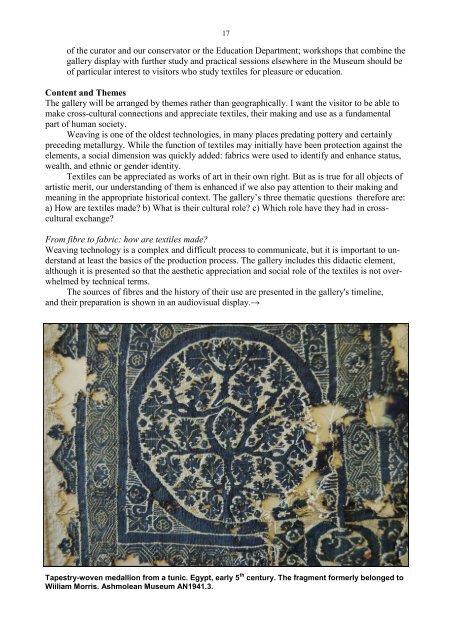Download - OATG. Oxford Asian Textile Group
Download - OATG. Oxford Asian Textile Group
Download - OATG. Oxford Asian Textile Group
Create successful ePaper yourself
Turn your PDF publications into a flip-book with our unique Google optimized e-Paper software.
17<br />
of the curator and our conservator or the Education Department; workshops that combine the<br />
gallery display with further study and practical sessions elsewhere in the Museum should be<br />
of particular interest to visitors who study textiles for pleasure or education.<br />
Content and Themes<br />
The gallery will be arranged by themes rather than geographically. I want the visitor to be able to<br />
make cross-cultural connections and appreciate textiles, their making and use as a fundamental<br />
part of human society.<br />
Weaving is one of the oldest technologies, in many places predating pottery and certainly<br />
preceding metallurgy. While the function of textiles may initially have been protection against the<br />
elements, a social dimension was quickly added: fabrics were used to identify and enhance status,<br />
wealth, and ethnic or gender identity.<br />
<strong>Textile</strong>s can be appreciated as works of art in their own right. But as is true for all objects of<br />
artistic merit, our understanding of them is enhanced if we also pay attention to their making and<br />
meaning in the appropriate historical context. The gallery‘s three thematic questions therefore are:<br />
a) How are textiles made b) What is their cultural role c) Which role have they had in crosscultural<br />
exchange<br />
From fibre to fabric: how are textiles made<br />
Weaving technology is a complex and difficult process to communicate, but it is important to understand<br />
at least the basics of the production process. The gallery includes this didactic element,<br />
although it is presented so that the aesthetic appreciation and social role of the textiles is not overwhelmed<br />
by technical terms.<br />
The sources of fibres and the history of their use are presented in the gallery's timeline,<br />
and their preparation is shown in an audiovisual display.→<br />
Tapestry-woven medallion from a tunic. Egypt, early 5 th century. The fragment formerly belonged to<br />
Wiiliam Morris. Ashmolean Museum AN1941.3.

















